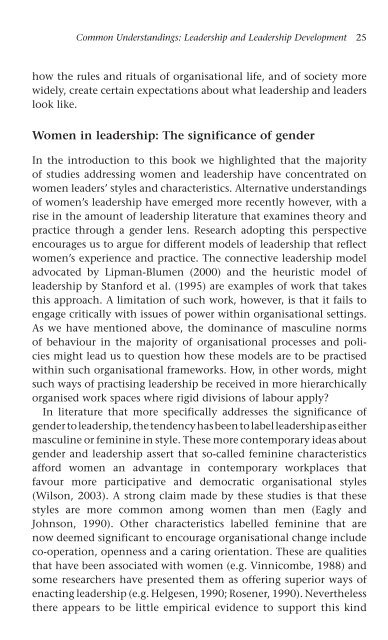Women's Leadership
Women's Leadership
Women's Leadership
You also want an ePaper? Increase the reach of your titles
YUMPU automatically turns print PDFs into web optimized ePapers that Google loves.
Common Understandings: <strong>Leadership</strong> and <strong>Leadership</strong> Development 25<br />
how the rules and rituals of organisational life, and of society more<br />
widely, create certain expectations about what leadership and leaders<br />
look like.<br />
Women in leadership: The significance of gender<br />
In the introduction to this book we highlighted that the majority<br />
of studies addressing women and leadership have concentrated on<br />
women leaders’ styles and characteristics. Alternative understandings<br />
of women’s leadership have emerged more recently however, with a<br />
rise in the amount of leadership literature that examines theory and<br />
practice through a gender lens. Research adopting this perspective<br />
encourages us to argue for different models of leadership that reflect<br />
women’s experience and practice. The connective leadership model<br />
advocated by Lipman-Blumen (2000) and the heuristic model of<br />
leadership by Stanford et al. (1995) are examples of work that takes<br />
this approach. A limitation of such work, however, is that it fails to<br />
engage critically with issues of power within organisational settings.<br />
As we have mentioned above, the dominance of masculine norms<br />
of behaviour in the majority of organisational processes and policies<br />
might lead us to question how these models are to be practised<br />
within such organisational frameworks. How, in other words, might<br />
such ways of practising leadership be received in more hierarchically<br />
organised work spaces where rigid divisions of labour apply?<br />
In literature that more specifically addresses the significance of<br />
gender to leadership, the tendency has been to label leadership as either<br />
masculine or feminine in style. These more contemporary ideas about<br />
gender and leadership assert that so-called feminine characteristics<br />
afford women an advantage in contemporary workplaces that<br />
favour more participative and democratic organisational styles<br />
(Wilson, 2003). A strong claim made by these studies is that these<br />
styles are more common among women than men (Eagly and<br />
Johnson, 1990). Other characteristics labelled feminine that are<br />
now deemed significant to encourage organisational change include<br />
co-operation, openness and a caring orientation. These are qualities<br />
that have been associated with women (e.g. Vinnicombe, 1988) and<br />
some researchers have presented them as offering superior ways of<br />
enacting leadership (e.g. Helgesen, 1990; Rosener, 1990). Nevertheless<br />
there appears to be little empirical evidence to support this kind
















